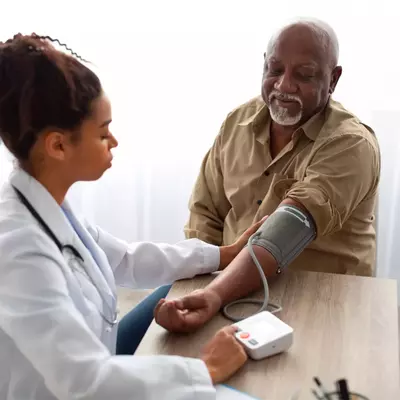- AdventHealth

Every six months, you look at your calendar and cringe.
Your dentist appointment is coming up.
The scraping. The drilling. The poking. The messiness.
And the worry that they'll find something.
But what if finding something could save your life?
You see, your dentist and dental hygienist aren't just about a pretty smile; they play an important role in the multidisciplinary approach to your overall health and wellbeing, especially when it comes to head and neck cancer. More than 50,000 people are diagnosed with head and neck cancers each year.** These cancers are found in the mouth, nose, throat, ear, thyroid and skin of the head and neck.
What They Do
Your dentist can be the first line of defense in screening for head and neck cancer as part of your routine dental exam. According to the Oral Cancer Foundation, a thorough head and neck cancer examination can take as little as five minutes.
Your dentist may look at and touch different structures of your head, mouth and neck to assess for abnormal masses, tissues, lesions and lymph nodes. This exam can provide a quick yet critically important general assessment of your:
- Skin
- Face
- Eyes
- Nose
- Ears
- Oral cavity
- Lips
- Cheeks
- Salivary glands
- Gums
- Tongue
- Hard and soft palate (roof of mouth)
- Floor of the mouth
- Tonsils
- Back of the throat
- Base of the tongue
- Neck
- Thyroid (usually palpated while swallowing)
Why It's Important
Head and neck cancers often do not show any warning signs until they advance to later stages, when they are more difficult to treat. Therefore, a routine head and neck cancer screening can offer the life-saving benefit of detecting potentially cancerous or precancerous lesions, and referring you to a specialists care for further evaluation and treatment to offer the best possible outcomes.
In addition, you should always be on the lookout for any signs and symptoms of head and neck cancer and talk about them with your dentist and primary care doctor. These symptoms can include:
- Pain, numbness or tenderness anywhere in your mouth or on your lips
- A change in color of any oral tissues
- A feeling as if something is caught in your throat
- Difficulty chewing, swallowing, speaking or moving the jaw or tongue
- A persistent sore throat
- A sore that doesn't heal or bleeds easily appearing on your lips, gums, tongue, cheek lining or other parts of your mouth
- Unexplained weight loss
- Persistent ear pain
- Any lump in the mouth, throat or neck
- Changes in your voice
- Unusual cough, especially one that produces blood
What You Can Do
As that impending six-month dental check-up approaches, think less about what's cringe-worthy and more about the positive things you are doing to help prevent head and neck cancer by:
- Seeing your dentist for routine dental check-ups twice per year.
- Talking to your dental health professionals and primary care doctor about your head and neck cancer risk factors, such as exposure to the human papilloma virus (HPV), smoking, heavy alcohol consumption and any form of tobacco use.
- Maintaining good oral hygiene habits and dental health.
- Seeing your primary care doctor at least once a year for a general physical.
Learn more about head and neck cancer here.
**Source: CancerNetwork.com



